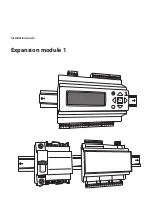
10
Inspection and servicing
Logano plus GB402 – 6 720 820 700 (2018/01)
35
10.4
Checking the heating system operating pressure
In sealed systems the pressure gauge needle must be within the green
marking.
The red needle of the pressure gauge must be set to the required
operating pressure.
▶ Check the operating pressure of the heating system.
The operating pressure is too low, if the pressure gauge needle is
below the green marking. Top up with water.
Fig. 42 Pressure gauge for sealed systems
[1]
Red needle
[2]
Pressure gauge needle
[3]
Green marking
▶ Top up the water via the on-site drain and fill valve.
▶ Vent the heating system via the radiator air vent valves.
▶ Check the operating pressure again.
▶ Enter the amount of top-up water in the "Water Quality Operator's
Log".
10.5
Measuring carbon dioxide content
▶ Insert the test sensor into the core flow through the test port in the
flue pipe
▶ Record the flue gas values.
If the CO
2
value deviates by more than 0,5 % from its set value
(
Table 4, page 9), adjust the burner as described in
Chapter 7.10, page 28 to 7.10.2, page 28.
Following applies for
Denmark
:
▶ Take the O
2
content corresponding to the specified CO
2
setting
values (natural gas DK CO
2
rat.=12.0 Vol. – %) from Chapter 12.5,
10.6
Clean burner and heat exchanger
Clean the boiler wet or dry.
A cleaning blade is available as an accessory for dry cleaning. Cleaning
equipment is available as an accessory for wet cleaning.
▶ Shut down the heating system (
▶ Close the gas main shut-off valve or gas tap.
▶ Allow the boiler to cool down.
▶ Remove siphon [2] from the outlet of condensate pan [1] and
position a bucket underneath the pan.
Fig. 43 Removing the siphon
[1]
Condensate pan outlet
[2]
Siphon
NOTICE:
Risk of system damage!
If the heating system is filled when hot, the resulting
temperature stresses can cause stress cracks. The
boiler can then leak.
▶ Only fill the heating system when cold (the flow
temperature should not exceed 40 °C).
▶
When the heating system is in operation, never
fill it via the boiler drain & fill valve. Instead, only
use the filling valve in the heating system
pipework (return).
▶ Pay attention to the water quality as specified in the
operator's log, and record the volume and quality of
fill water used.
NOTICE:
System damage due to frequent topping up!
Depending on water quality, the heating system may be
damaged by corrosion or scaling if you frequently need
to top up the water (observe the water quality log).
▶ Vent the heating system during filling.
▶ Check the heating system for leaks.
▶ Check the function of the expansion vessel.
Establish an operating pressure of at least 1 bar.
CAUTION:
Health risk from contaminated drinking
water!
▶ Observe all regulations and standards applicable in
your country regarding the prevention of drinking
water contamination.
▶ In Europe, observe standard EN 1717.
6 720 615 876-59.2T
3
2
1
The operating pressure can also be checked at the
control unit via the "Info menu" (e.g. display "P1.4"
corresponds to 1.4 bar).
NOTICE:
Material damage if there is burner operation
with too high a CO
2
content!
Permanent operation with excessive CO
2
content can
cause damage to the burner rod and burner.
▶ Observe the CO
2
contents for full load and partial
load, which are given in the technical
documentation.
Summary of Contents for GB402-320-5
Page 62: ...Logano plus GB402 6 720 820 700 2018 01 62 Notes...
Page 63: ...Logano plus GB402 6 720 820 700 2018 01 63 Notes...
Page 64: ......
















































